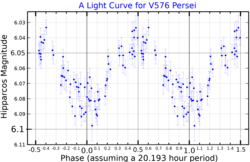Astronomy:HD 21071
| Observation data Equinox J2000.0]] (ICRS) | |
|---|---|
| Constellation | Perseus |
| Right ascension | 03h 25m 57.382s[2] |
| Declination | +49° 07′ 14.73″[2] |
| Apparent magnitude (V) | 6.09[3] |
| Characteristics | |
| Spectral type | B7 V[4] |
| B−V color index | −0.073±0.005[3] |
| Variable type | SPB[5] |
| Astrometry | |
| Radial velocity (Rv) | −1.5±0.9[6] km/s |
| Proper motion (μ) | RA: +23.753[2] mas/yr Dec.: −26.656[2] mas/yr |
| Parallax (π) | 6.0959 ± 0.0444[2] mas |
| Distance | 535 ± 4 ly (164 ± 1 pc) |
| Absolute magnitude (MV) | −0.19[3] |
| Details | |
| Mass | 3.69+0.14 −0.15[5] M☉ |
| Radius | 2.21[7] R☉ |
| Luminosity | 278.0+53.1 −44.7[5] L☉ |
| Surface gravity (log g) | 4.30[4] cgs |
| Temperature | 14,768[4] K |
| Metallicity [Fe/H] | 0.0082+0.0053 −0.0032[5] dex |
| Rotational velocity (v sin i) | 58[4] km/s |
| Age | 90[4] Myr |
| Other designations | |
| Database references | |
| SIMBAD | data |
HD 21071 is a blue-white hued variable star in the northern constellation of Perseus. Also known as V576 Persei, it is a sixth magnitude star that is dimly visible to the naked eye under good viewing conditions, having an apparent visual magnitude of 6.09.[3] The brightness of the star varies with a multiperiodic cycle.[9] The distance to HD 21071, as determined from an annual parallax shift of 6.1 mas,[2] is 535 light years. It is a member of the young Alpha Persei cluster, Melotte 20,[4][10] and moving is closer to the Earth with a heliocentric radial velocity of −1.5 km/s.[6]
This is a B-type main-sequence star with a stellar classification of B7 V.[4] HD 21071 belongs to an unusual stellar population termed 'sn' stars. These seem to be related to chemically peculiar stars, but have sharp ('s') Balmer and metal absorption lines with "broad coreless He I" ('n') lines. The latter wide, "nebulous" lines may be due to Stark broadening caused by an electric field.[4] HD 21071 is a slowly pulsating B-type star (SPB star) that was initially found to vary with a period of 0.84 days. Further study revealed four frequencies, with the two dominant, higher amplitude frequencies having similar cycles of 1.19 and 1.15 per day.[5]
| ID | Frequency (d−1) |
V Amplitude (mmag) |
Radial Velocity (km/s) |
|---|---|---|---|
| 1 | 1.18843 | 18.5 | 3.28±0.85 |
| 2 | 1.14934 | 7.7 | – |
| 3 | 1.41968 | 3.8 | – |
| 4 | 0.95706 | 3.0 | – |
Stellar models show the star to have 3.7[5] times the mass of the Sun, with 2.21[7] times the Sun's radius. It is 90[4] million years old with a near-solar metallicity and is spinning with a projected rotational velocity of 58 km/s.[4] The star is radiating 278[5] times the Sun's luminosity from its photosphere at an effective temperature of 14,768 K.[4]
References
- ↑ Light Curve, ESA, https://www.cosmos.esa.int/web/hipparcos/java-tools/light-curve, retrieved 19 September 2022.
- ↑ 2.0 2.1 2.2 2.3 2.4 Brown, A. G. A. (2021). "Gaia Early Data Release 3: Summary of the contents and survey properties". Astronomy & Astrophysics 649: A1. doi:10.1051/0004-6361/202039657. Bibcode: 2021A&A...649A...1G. Gaia EDR3 record for this source at VizieR.
- ↑ 3.0 3.1 3.2 3.3 Anderson, E.; Francis, Ch. (2012), "XHIP: An extended hipparcos compilation", Astronomy Letters 38 (5): 331, doi:10.1134/S1063773712050015, Bibcode: 2012AstL...38..331A.
- ↑ 4.00 4.01 4.02 4.03 4.04 4.05 4.06 4.07 4.08 4.09 4.10 Saffe, C.; Levato, H. (February 2014), "On the nature of sn stars. I. A detailed abundance study", Astronomy & Astrophysics 562: 17, doi:10.1051/0004-6361/201322091, A128, Bibcode: 2014A&A...562A.128S.
- ↑ 5.0 5.1 5.2 5.3 5.4 5.5 5.6 5.7 Szewczuk, W.; Daszyńska-Daszkiewicz, J. (October 2015), "Seismic modelling of the rotating, slowly pulsating B-type star HD 21071", Monthly Notices of the Royal Astronomical Society 453 (1): 277–286, doi:10.1093/mnras/stv1589, Bibcode: 2015MNRAS.453..277S.
- ↑ 6.0 6.1 Gontcharov, G. A. (November 2006), "Pulkovo Compilation of Radial Velocities for 35495 Hipparcos stars in a common system", Astronomy Letters 32 (11): 759–771, doi:10.1134/S1063773706110065, Bibcode: 2006AstL...32..759G.
- ↑ 7.0 7.1 Mathias, P. et al. (December 2001), "Spectroscopic monitoring of 10 new northern slowly pulsating B star candidates discovered from the HIPPARCOS mission", Astronomy and Astrophysics 379 (3): 905–916, doi:10.1051/0004-6361:20011406, Bibcode: 2001A&A...379..905M, https://orbi.uliege.be/bitstream/2268/132480/1/aa1651.pdf.
- ↑ "HD 21071". SIMBAD. Centre de données astronomiques de Strasbourg. http://simbad.u-strasbg.fr/simbad/sim-basic?Ident=HD+21071.
- ↑ Samus, N. N. et al. (2017), "General Catalogue of Variable Stars", Astronomy Reports, GCVS 5.1 61 (1): 80–88, doi:10.1134/S1063772917010085, Bibcode: 2017ARep...61...80S.
- ↑ Zuckerman, B. et al. (June 2012), "Stellar Membership and Dusty Debris Disks in the α Persei Cluster", The Astrophysical Journal 752 (1): 12, doi:10.1088/0004-637X/752/1/58, 58, Bibcode: 2012ApJ...752...58Z.
 |


